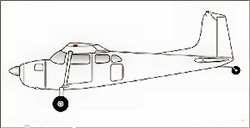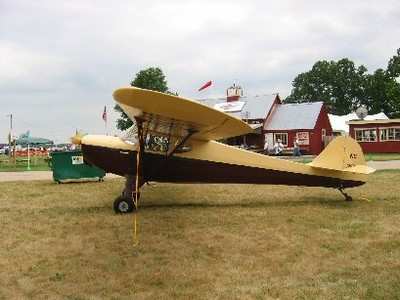SEE and AVOID!!!!
 No Mid-Air is the result of a single error... but a series of
errors in which the avoidance of any one factor might have averted
disaster for all concerned. In this case, two high-wing aircraft's
flight paths converged... with a surprisingly survivable result. It
doesn't usually end this way. Read on and learn a few things from
the sequence of events that almost destroyed two aircraft and their
crews.
No Mid-Air is the result of a single error... but a series of
errors in which the avoidance of any one factor might have averted
disaster for all concerned. In this case, two high-wing aircraft's
flight paths converged... with a surprisingly survivable result. It
doesn't usually end this way. Read on and learn a few things from
the sequence of events that almost destroyed two aircraft and their
crews.
NTSB Identification: WPR11LA068B
14 CFR Part 91: General Aviation
Accident occurred Wednesday, December 01, 2010 in Madras, OR
Aircraft: CESSNA 185A, registration: N1699Z
Injuries: 4 Uninjured.
This is preliminary information, subject to change, and may
contain errors. Any errors in this report will be corrected when
the final report has been completed.
On December 1, 2010, about 1130 Pacific standard time, the
propeller of a Taylorcraft BC-65, N23619, and the aft portion of
the empennage of a Cessna 185A, N1699Z, came in contact with each
other while both aircraft were on visual flight rules (VFR) final
approach to Madras Airport, Madras, Oregon. The certified flight
instructor (CFI) and in his student in the Taylorcraft, which was
not radio equipped, were not injured, but the airplane, which is
owned and operated by Berg Air, sustained substantial damage. The
airline transport pilot and his passenger in the Cessna were also
uninjured, but the Cessna, which was owned and operated by the
passenger, also sustained substantial damage. The occupants of the
Taylorcraft were on a 14 Code of Federal Regulations Part 91 local
instructional flight, and the occupants of the Cessna were on a 14
Code of Federal Regulations Part 91 personal pleasure flight. The
pilot of the Cessna was on his second circuit of the VFR pattern,
and the occupants of the Taylorcraft were on their first of a
planned multiple circuits of the VFR pattern after returning from a
training flight in the local area. Neither aircraft was on a flight
plan.

C185 Illustration
According to the occupants of the Taylorcraft, they did not see
the Cessna until they were on short final, whereupon the empennage
of the Cessna suddenly appeared underneath and very close to the
left wing of their airplane. The CFI, who was flying at the time,
immediately tried to bank to the right, but the propeller of the
Taylorcraft came in contact with the Cessna before he could gain
separation. After impacting the Cessna, the Taylorcraft's propeller
stopped turning, and therefore the CFI made a power-off landing on
the extended 1,800-foot paved stop-way of the old military
runway.
According to the pilot of the Cessna, neither occupant ever saw
the Taylorcraft, but while on short final they heard a loud bang
come from the aft end of their airplane. Immediately after they
heard the bang, the airplane pitched down and rolled to the right,
but the pilot was able to regain control and continue flying
straight ahead. Because the occupants were unaware that their
airplane had come in contact with another airplane, and because
they thought they had either impacted a large bird or experienced
some sort of mechanical failure, they elected to climb straight
ahead and land at their home airport, which was about 10 minutes
away. It was not until after landing at their home airport and
inspecting the airplane that the occupants of the Cessna realized
there had been a mid-air collision.

Taylorcraft File Photo
At the time of the accident, there were scattered clouds about
3,000 feet above ground level (AGL) and a visibility of more than
10 miles.
 Airbus Racer Helicopter Demonstrator First Flight Part of Clean Sky 2 Initiative
Airbus Racer Helicopter Demonstrator First Flight Part of Clean Sky 2 Initiative Diamond's Electric DA40 Finds Fans at Dübendorf
Diamond's Electric DA40 Finds Fans at Dübendorf ANN's Daily Aero-Term (04.23.24): Line Up And Wait (LUAW)
ANN's Daily Aero-Term (04.23.24): Line Up And Wait (LUAW) NTSB Final Report: Extra Flugzeugbau GMBH EA300/L
NTSB Final Report: Extra Flugzeugbau GMBH EA300/L Classic Aero-TV: 'Never Give Up' - Advice From Two of FedEx's Female Captains
Classic Aero-TV: 'Never Give Up' - Advice From Two of FedEx's Female Captains





